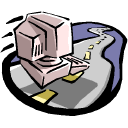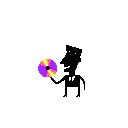|

Mobile computing
is made possible by a combination of three things. A network (Sprint has the most extensive built for high speed data), a computing device (laptop, tablet, or palm type), and the software to make everything work together.
Sprint has done their part by building a nationwide network with speeds of up to 144 kbps, security with dynamic IP assignments, and the flexibility to work with both laptop and tablet computing devices.
In palm type devices, you have a choice of the Palm or Windows operating systems built right into the phone! Whether the Palm or Pocket PC operating system will prevail is subject to many opinions. All we call tell you is that the Palm OS is also supported by Handspring and Sony and is the by far the more established to the two systems with software available for almost every conceivable application.
The Pocket PC operating system requires a somewhat larger device at significantly higher cost. Still, it is supported by Dell, HP, Toshiba, and Viewsonic. We think Sony learned their lesson with Betamax. Do you remember that they had ALL the home video tape recording market before VHS? The good news is that you dont have to outguess market trends. Sprint has made both Palm and Pocket PC operating systems available for those who want wireless mobility.

Networks..
essentially come in two types. Wired and wireless. Most of us became involved with computer networking by paying someone a lot of money to install cable throughout our facility. Later, a wireless protocol came along known as 802.11 that revolutionized connectivity. This technology is great for short range line of site applications but generally not well suited for mobile data applications.
Those who want access to central files from a remote wireless device have generally limited, and somewhat expensive solutions. The most common are as follows:
Slow Speed Analog Data Modems
provide data rates ranging from 300 to 9600 baud using conventional 2-way radios. This is generally acceptable for sending and receiving secure text messages. It is unacceptable for computer file sharing or transmission of photos and images. Low cost packet modems are available from CES, MFJ Enterprises, and others, that can be connected directly to radios such as the Vertex VX4000 which has a nine pin data port. Although relatively inexpensive, this would not be a good solution for most commercial and governmental users.
Data Radio Systems
are hybrid radios designed specifically to handle faster data speeds. The primary manufacturer is Data Radio. We understand the company advertises data rates of up to 28 kbps over a standard 2-way radio channel. Remember, this is about half the speed of a 56 kbps dial up modem for your home PC. That isnt exactly fast. These systems tend to be a little priced with the average cost per mobile being in the nine thousand dollar range and the cost of each repeater station being in the sixty thousand dollar range. In many instances, more than one station is required to provide coverage with the cost of such systems often being in the multi-million dollar range.
Public Wireless Networks
are offered by most cellular phone providers to allow data communications. Speeds will vary depending on the technology used by the carrier. The older analog systems used in rural areas are virtually useless for data purposes. The iDEN technology used by Nextel and SouthernLINC supports speeds of up to 19.2 kbps. The best nationwide network for high-speed data at this time is Sprint PCS with speeds of up to 144 kbps. We feel that this is a good interim, and perhaps a good long-term solution, since you pay a monthly charge only for the data used. Rates begin at under $40 monthly and unlimited use is available for under $100 monthly.
Other Technologies
include the so-called 4G, of fourth generation technology that uses the 2.4, 3.5, 5.2 or 5.7 GHz bands for variations of the long-range 802.11 standards. This technology is perfectly suited to fixed locations with data rates of up to 11 mbps. However, it is not yet suitable for mobile use. This could change in the very near future. For now, we still feel Sprint PCS is your best choice.

Devices
The wireless device can be one capable of handling only voice, only data, or both. In public safety and many commercial applications, the primary objective is to attain instant communications with moderate to high levels of security. The most common solution to meeting this requirement is known as a trunking radio system. This is simply a technical way of describing a multi-channel VHF or UHF radio system using dynamic channel assignment.
There are two basic types of systems single site and multi-site. For single site applications, the most popular format is known as LTR. This is endorsed by Motorola, Kenwood, Relm, and Vertex among other lesser-known suppliers. Multi-site systems connected by microwave, TI, satellite, or the Internet are used to provide coverage over a broad geographic area with all transmitter locations being coordinated by a central controller. These systems allow seamless roaming from one coverage area to another. This is essentially the principal employed by iDEN technology used by Nextel and SouthernLINC.
Private multi-site systems come in two variations digital and analog. The DVIP system from Digital Wireless utilizes a proprietary digital format. A more common, but less efficient, system known as APCO-25 is available from most major manufacturers including the Bendix-King division of Relm Wireless.
Private user analog systems with multi-site capability are offered by Trident Systems under the name Passport and by Relm Wireless using the Uniden ESAS technology. Passport technology is supported by Motorola, Kenwood, and Vertex while Relm has chosen the ESAS technology. We are most impressed by ESAS as the premier analog system. Additional information is available by clicking on the picture of the ESAS mobile below.

Public System Devices
Public digital communications systems differ significantly from privately owned systems primarily in the type of devices used. Private systems are nominally designed for fixed mobile equipment typically consisting of a radio transceiver and an associated keyboard or PC. Handheld held radio devices are available for LTR, ESAS, and APCO-25 systems but they tend to a little large, pricey and limited primarily to voice communications.
Conversely, public systems favor personal devices that can be easily worn on the person. This is due to the difference in system infrastructure. Public systems have many transmissions cells capable of communicating over very limited range, sometimes less than a mile. Private systems do not have the luxury of a vast network of stations. Accordingly, private systems use fewer stations with higher power required in the user equipment. Higher-powered user equipment means higher cost, larger size, and more limited features. Economically, private systems cost more initially for equipment but have no monthly airtime charges, or comparatively low monthly costs compared to public systems.
The industry is in a state of transition. Companies like Digital Wireless will soon be offering personal equipment with features comparable to state of the art public systems. For the moment, we recommend using Sprint PCS wireless data services, not only as an interim solution, but also potentially as an ongoing alternative. Now, we will look at some of the more popular devices available for use on the Sprint PCS 3G network. It should be noted that we do not offer first or second-generation technology. We are technical innovators and recognize that outdated technology in the marketplace of today has little or no value, regardless of initial price. For additional information on the Sprint PCS 3G network and the devices currently available, just click on the icon below.
 
Software
The engine that drives the wheels of mobile computing is the software! The network distributes the information. The device conveys the information and the software provides the resources to make it all happen!
When computers were first introduced, people rushed out to buy Commodore, Sinclair, IBM, and Radio Shack expecting the computer to solve all their needs. It did not work out quite that way. The first company, to our knowledge, to recognize both the need for portability and integrated software solution was an English company known as Psion. It was at that time that the concept of mobile data became a reality. As good as they were, these devices depended on software within the device.
The along came a group of amateur radio operators, from Hawaii, and later Arizona, who introduced us to the concept of exchanging wireless data through devices known as packet modems. In essence, a packet modem converts analog information, which can be voice or keyboard strokes, or oven pictures, into a digital format that is sent over the air in a series of information packets. At the receiving end, these digital data packets are converted from digital format back to analog. Such devices are sometimes called A to D converters.
A modern mobile computing device consists of the A to D converter, a means of entering data which is most commonly a keyboard, a display or monitor, a data storage system for storage and retrieval of data plus the operating system and associated software.
Operating systems
The most popular operating system for personal computers is the Windows operating system. Years ago IBM developed an excellent multi-tasking Operating System or OS well before Windows was able to provide such capability. Also years ahead of Windows in terms of simplicity is the Apple Macintosh OS, the first to use graphical interface icons, or in simple terms; the ability to select functions by pointing and clicking.
As our needs for computing grew, we developed a need for multiple computers to share a common database. The main computer, or server, became the brains for the office network. The early Windows systems, prior to NT were notorious for crashing at inopportune times. As a result, one man, assisted by thousands of unpaid contributors around the world developed a new operating system called Linux. At this time, Linux is primarily used for server applications, and to a much lesser extent for personal computers, but to our knowledge not yet used for laptop, tablet, or PDA applications.
Since most mobile data systems are built around laptops, tablets, or personal digital assistants; it is necessary to understand the operating systems as they apply to mobile computing at this time.
For laptop computers, the most popular operating system is Windows 2000, ME, and most recently XP all incorporate much of the stability of the NT system. Tablet computers typically will also use the Windows operating system, but when we get to personal data assistants or PDAs, the standard changes.
The most popular operating system for a PDA is the Palm OS used by Palm, Handspring and Sony. However, you can never count out Microsoft who has developed a compressed version of Windows known as Pocket PC. The devices are heavier with reduced battery life and higher cost, but the graphics are great and it can be a compromise to for those who prefer a limited version of Windows when away from the home or office.
Currently, there is a lot more software available for Palm OS than Pocket PC. Personally, we feel the Handspring Treo 300, using the Palm OS with integrated phone and keyboard is the preferred choice at his time. For those who prefer the Pocket PC OS, the preferred choice, in our opinion is the Toshiba 2032. Both are available at our web store. Now, we will review software options.

Software to suit your needs
If you are using a PDA with the Palm operating system, you can store a great deal of information on internal storage of the device, such as the Handspring Treo 300.
If you have a remote database, such as Microsoft Outlook or Lotus Notes, you can access these files using software suitable for this purpose. The Business Connection software by Sprint can provide this function. There are other programs capable of providing this same function at minimal cost for those users who do not wish to pay the monthly charge for Business Connection. One of the better ones is Memo to Me. You get a scheduler and reminder service for FREE plus a $12 annual fee to provide forwarding of your office email to your wireless PDA. Click on the link below for additional information.

There are essentially three types of software. The first is free. There are different variations of free. Some software providers provide their products at little or no cost with revenue generate by popup ads or banners. Another form of free software is the aforementioned Memo To Me plus an enhancement known as shareware. The shareware concept is based on paying for value. In the case of Memo To Me, you are invited to pay what you think the program is worth. Since the minimum acceptable bid for the email forwarding portion of Memo To Me is $12 annually; that basically becomes the cost.
There are other software providers who charge you depending on the number of licensed users. Typically, you pay a license fee for the software plus an additional amount for each user of PC on the system. Larger system providers such as Intergraph and Vision who write programs for public safety users will also add an additional fee for maintenance and support. These systems tend to be relatively expensive compared to packaged systems, but provide much more capability. Packaged systems, such as QuickBooks and other application type programs can be very effective as long as your needs can be served by the software in unmodified form.
Many software providers do not allow you to modify their software. The Windows operating system is such as example. Others will let you you make changes by providing the source code. The Linux operating system is such an example. Generally, a vendor who offers their source code will be one who offers specialized programs with the cost being significantly higher than package systems that cannot be altered.
The third type of software provider is the one who serves your needs from a central processor. In this application, the data resides on the providers server and you are charged a monthly fee for usage. If you have a Home Page on the Internet, you are using this type application.
|

